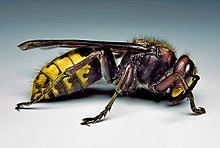Vespa crabro
| European hornet | |
|---|---|
 |
|
| A female European hornet | |
| Scientific classification | |
| Kingdom: | Animalia |
| Phylum: | Arthropoda |
| Class: | Insecta |
| Order: | Hymenoptera |
| Family: | Vespidae |
| Genus: | Vespa |
| Species: | V. crabro |
| Binomial name | |
|
Vespa crabro Linnaeus, 1758 |
|
The European hornet (Vespa crabro) is the largest eusocial wasp in Europe and the largest vespine in North America. It is actually the only true hornet found in North America.V. crabro is usually regarded as a pest by those humans who come into contact with it. Vespines, like V. crabro, are known for making nests out of surrounding plant materials and other fibers to create intricate paper nests. Unlike most other vespines, reproductive suppression involves worker policing instead of queen pheromone control as was previously thought.
This species stings in response to being stepped on or grabbed, but generally avoids conflict. They are also defensive of their hive and can be aggressive around food sources. They are carnivorous and eat large insects, primarily wasps, large moths, and large bees. Care should be taken when they are encountered in these circumstances, as they may sting without warning. The pain from the sting may persist for several days with attendant swelling. Victims may wish to seek medical attention in case of allergic reaction.
The European hornet is a true hornet (genus Vespa), a group characterized by eusocial species. The genus is in the subfamily Vespinae, which is known for chewing up their food to feed it to their young as well as chewing up paper-like materials to make their nests. According to a recent phylogenetic study, its closest relative is Vespa dybowski.
The eyes of V. crabro are deeply indented and shaped like a "C". Its wings are reddish-orange, while the petiolate abdomen is striped with brown and yellow. It has hair on the thorax and abdomen, although the European hornet is not as hairy as most bees. Typical mass size for the European Hornet is 477.5+/-59.9 mg. Due to this coloration and abdomen pattern, V. crabro is often mistaken for the Asian giant hornet. In size, the European hornet, at 25–35 mm long, is larger than the common wasp, but smaller than the Asian giant hornet. Females are typically larger than males in both size and mass. However, male abdomens have seven segments, whereas female abdomens have six. Only females possess an ovipositor (modified to form a stinger), and males cannot sting. The antennae of males are slightly longer, with 13 segments compared to 12 segments in females.
...
Wikipedia
